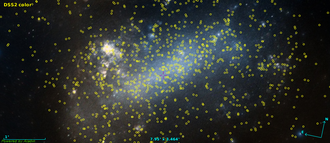
The stars with the initial mass range of about 1-8 Mo lose most of their mass during the asymptotic giant branch (AGB) phase. Once the star leaves the AGB, it starts to increase its surface temperature until planetary nebula (PN) is formed due to ionization of the ejected gas. Post-AGB stars comprise a group of objects in the transition stage between the AGB and PN. Only about 300 post-AGB stars are known in our Galaxy. This small number is due primarily to their short evolutionary timescale, which is of order of 1000 yr.
An international team of astronomers, incuding scientists from the Copernicus Center, selected a sample of post-AGB candidates in the Magellanic Clouds on the basis of their near- and mid-infrared color characteristics. Fifteen of the brightest post-AGB candidates were observed with the South African Large Telescope (SALT) in order to determine their stellar parameters and thus to validate or discriminate their nature as post-AGB objects. The effective temperature of absorption-line objects were obtained by means of stellar atmosphere modeling. Out of 15 observed objects, only 4 appear to be genuine post-AGB stars. Thus, we can conclude that the selected region in the applied color-color diagram , while selecting the genuine post-AGB objects, overlaps in particular with young stellar objects and planetary nebulae. However, we showed that the low-resolution optical spectra, like those obtained by SALT, appear to be sufficient to determine whether the candidates are post-AGB objects.
Picture: Distribution of known post-AGB objects in the LMC-SMC system of galaxies






